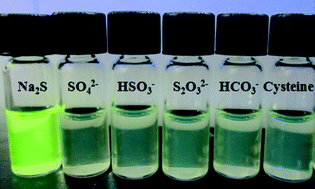A polymer-based turn-on fluorescent sensor for specific detection of hydrogen sulfide†
Abstract
Hydrogen sulfide (H2S) is accepted as a third “gasotransmitter’’ of human physiology and pathology but remains difficult to study, in large part because of the lack of methods for the selective monitoring of this small signaling molecule in live biological specimens. We now report a new reaction-based polymeric fluorescent sensor for selective imaging of H2S in living cells. A novel functional monomer, 2-allyl-1,3-dioxo-2,3-dihydro-1H-benzo[de]isoquinoline-6-sulfonyl azide (AISA) was firstly synthesized and copolymerized with styrene to obtain a polymeric fluorescent sensor material. AISA and poly(styrene-co-AISA) (PSAISA) showed a fast turn-on fluorescence signal enhancement and a high selectivity for hydrogen sulfide (H2S) over other biologically relevant species including HSO3−, SO42−, S2O32− and cysteine. Furthermore, upon reaction with H2S, PSAISA gave a strong spectral response changing from colorless to bright yellow. FT-IR and 1H NMR data confirmed that the fluorescence enhancement of PSAISA was caused by the reduction of sulfonyl azide to sulfonamide in the presence of H2S. This property was successfully used to image H2S in living cells, thus demonstrating the potential of this material in biosensor applications.


 Please wait while we load your content...
Please wait while we load your content...